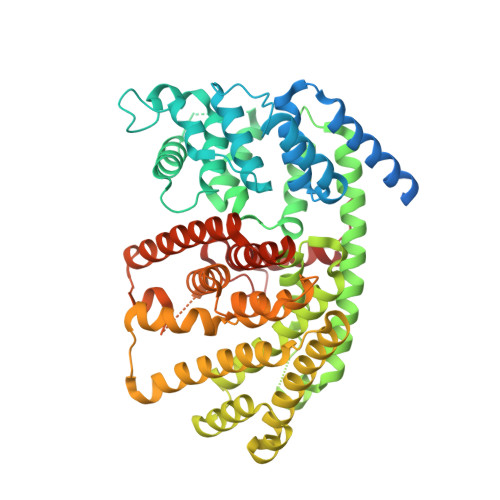Rational Conversion of Substrate and Product Specificity in a Salvia Monoterpene Synthase: Structural Insights Into the Evolution of Terpene Synthase Function.
Kampranis, S.C., Ioannidis, D., Purvis, A., Mahrez, W., Ninga, E., Katerelos, N.A., Anssour, S., Dunwell, J.M., Degenhardt, J., Makris, A.M., Goodenough, P.W., Johnson, C.B.(2007) Plant Cell 19: 1994
- PubMed: 17557809
- DOI: https://doi.org/10.1105/tpc.106.047779
- Primary Citation of Related Structures:
2J5C - PubMed Abstract:
Terpene synthases are responsible for the biosynthesis of the complex chemical defense arsenal of plants and microorganisms. How do these enzymes, which all appear to share a common terpene synthase fold, specify the many different products made almost entirely from one of only three substrates? Elucidation of the structure of 1,8-cineole synthase from Salvia fruticosa (Sf-CinS1) combined with analysis of functional and phylogenetic relationships of enzymes within Salvia species identified active-site residues responsible for product specificity. Thus, Sf-CinS1 was successfully converted to a sabinene synthase with a minimum number of rationally predicted substitutions, while identification of the Asn side chain essential for water activation introduced 1,8-cineole and alpha-terpineol activity to Salvia pomifera sabinene synthase. A major contribution to product specificity in Sf-CinS1 appears to come from a local deformation within one of the helices forming the active site. This deformation is observed in all other mono- or sesquiterpene structures available, pointing to a conserved mechanism. Moreover, a single amino acid substitution enlarged the active-site cavity enough to accommodate the larger farnesyl pyrophosphate substrate and led to the efficient synthesis of sesquiterpenes, while alternate single substitutions of this critical amino acid yielded five additional terpene synthases.
Organizational Affiliation:
Department of Natural Products and Biotechnology, Mediterranean Agronomic Institute of Chania, Chania, Greece. sotirios@maich.gr















